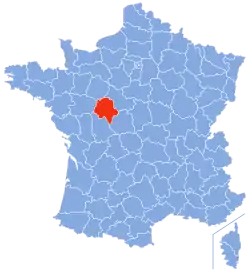| 2014 Tours stabbing attack | |
|---|---|
| Part of Islamic terrorism in Europe | |
 | |
| Location | Joué-lès-Tours, France |
| Coordinates | 47°21′07″N 0°39′44″E / 47.3520°N 0.6622°E |
| Date | 20 December 2014 |
| Target | Police officers |
Attack type | Stabbing |
| Weapons | Knife |
| Deaths | 1 (the perpetrator) |
| Injured | 3 |
| Perpetrator | Bertrand Nzohabonayo |
| Motive | Islamist terrorism inspired by ISIL[1][2] |
On 20 December 2014, a man in Joué-lès-Tours near the city of Tours in central France entered a police station and attacked officers with a knife, shouting "Allahu Akbar" and injuring three before he was shot and killed. The attack was categorised as a case of religiously inspired terrorism by Europol,[2] and has been reported by Europol as well as mappings by CNN and AFP as inspired by the Islamic State of Iraq and the Levant (ISIL).[1][3][4]
Perpetrator
The attacker was identified as Bertrand Nzohabonayo, age 20, a French citizen and former rap musician born in Burundi in 1994, he was known to the police for minor crimes but was not on any watchlist.[5][6][7][8] The attacker had taken Bilal as his new name upon conversion to Islam, and had been posting Islamist material on his Facebook page, including a photograph of the black flag of the Islamic State.[9][10]
In Burundi, police arrested the attacker's brother, a man with known Islamist sympathies and claimed that they had informed French authorities the previous year that both brothers should be regarded as suspect due to their extreme religious views.[11]
Motivation
The Financial Times described the attack, along with the vehicle-ramming attacks on 21 December in Dijon and 22 December in Nantes as "the first ISIS-linked attacks" in France.[12] According to The Globe and Mail, the attack was "apparently inspired by a video" circulated by ISIL calling on French Muslims to attack non-Muslims using vehicles.[13] According to David C. Rapoport of the University of California, Los Angeles, these three attacks can be understood in the context of the rise of the Islamic State in Syria. "In September 2014, after the U.S. organized its airstrikes, the Islamic State’s chief spokesman called on Muslims in Western countries to find an infidel and ‘smash his head with a rock’, poison him, run him over with a car or ‘destroy his crops’. Two months later a video released in French contained virtually the same message and a series of strange 'lone wolf' attacks followed on three consecutive days, the perpetrators declaring “'God is Great' in Arabic. Three policemen were stabbed in Joué-lès-Tours, and vehicles were used to run over eleven pedestrians in Dijon and ten in Nantes."[14]
Aftermath
The attack was categorised as "religiously inspired terrorism" by Europol, as reported to them by France.[2] Following this attack, the 2014 Dijon attack and 2014 Nantes attack, which were deemed to be unrelated, the French government heightened the nation's security.[15]
See also
References
- 1 2 Changes in Modus Operandi of Islamic State (IS) revisited (Report). Europol. November 2016. p. 7.
- 1 2 3 "EU Terrorism Situation and Trend Report (TE-SAT) 2015". EU Terrorism Situation & Trend Report (Te-Sat). Europol: 18. 2015. ISBN 978-92-95200-56-2.
- ↑ Lister, Tim; Sanchez, Ray; Bixler, Mark; O'Key, Sean; Hogenmiller, Michael; Tawfeeq, Mohammed (February 13, 2017). "ISIS goes global: 143 attacks in 29 countries have killed 2,043". CNN.
- ↑ "Timeline: How jihadists have targeted soldiers and police in France". thelocal.fr. AFP. September 15, 2017.
- ↑ "French police shoot dead knifeman who was shouting Islamic slogans". The Daily Telegraph. December 20, 2014. Retrieved November 16, 2015.
- ↑ Lichfield, John (December 21, 2014). "Man shot dead by police in jihadist attack in Tours". The Independent. Archived from the original on May 1, 2022. Retrieved November 17, 2015.
- ↑ Rodrigues, Jason (January 16, 2015). "Terror attacks in Europe: the five danger zones". The Guardian. Retrieved November 17, 2015.
- ↑ "France Dijon: Driver targets city pedestrians". BBC News. December 21, 2014. Retrieved December 22, 2014.
- ↑ Cruickshank, Paul (November 16, 2015). "Drumbeat of terror precedes slaughter that shocks France and the world". CNN. Retrieved November 17, 2015.
- ↑ Mulholland, Rory (December 21, 2014). "French knife attacker Bertrand Nzohabonayo was Islamic convert; Man shot dead by French police had changed name to Bilal and posted ISIL flag on Facebook". The Daily Telegraph. Retrieved November 16, 2015.
- ↑ "Burundi arrests brother of suspect in French police attack". France 24. December 22, 2014. Retrieved November 16, 2015.
- ↑ Jones, Sam (July 15, 2016). "France emerges as main focus for terrorists". Financial Times. ProQuest 1811254498.
- ↑ Martin, Patrick (July 15, 2016). "History of lone-wolf vehicle attacks suggests risk of emulation is very rea". The Globe and Mail. Retrieved July 15, 2016.
- ↑ Rapoport, David (2016). "Why Has The Islamic State Changed its Strategy and Mounted the Paris-Brussels Attacks?". Perspectives on Terrorism; Terrorism Research Initiative; University of Leiden. 10 (2). Retrieved October 18, 2017.
- ↑ "France to deploy soldiers after spate of attacks". BBC News. December 23, 2014. Retrieved December 26, 2014.